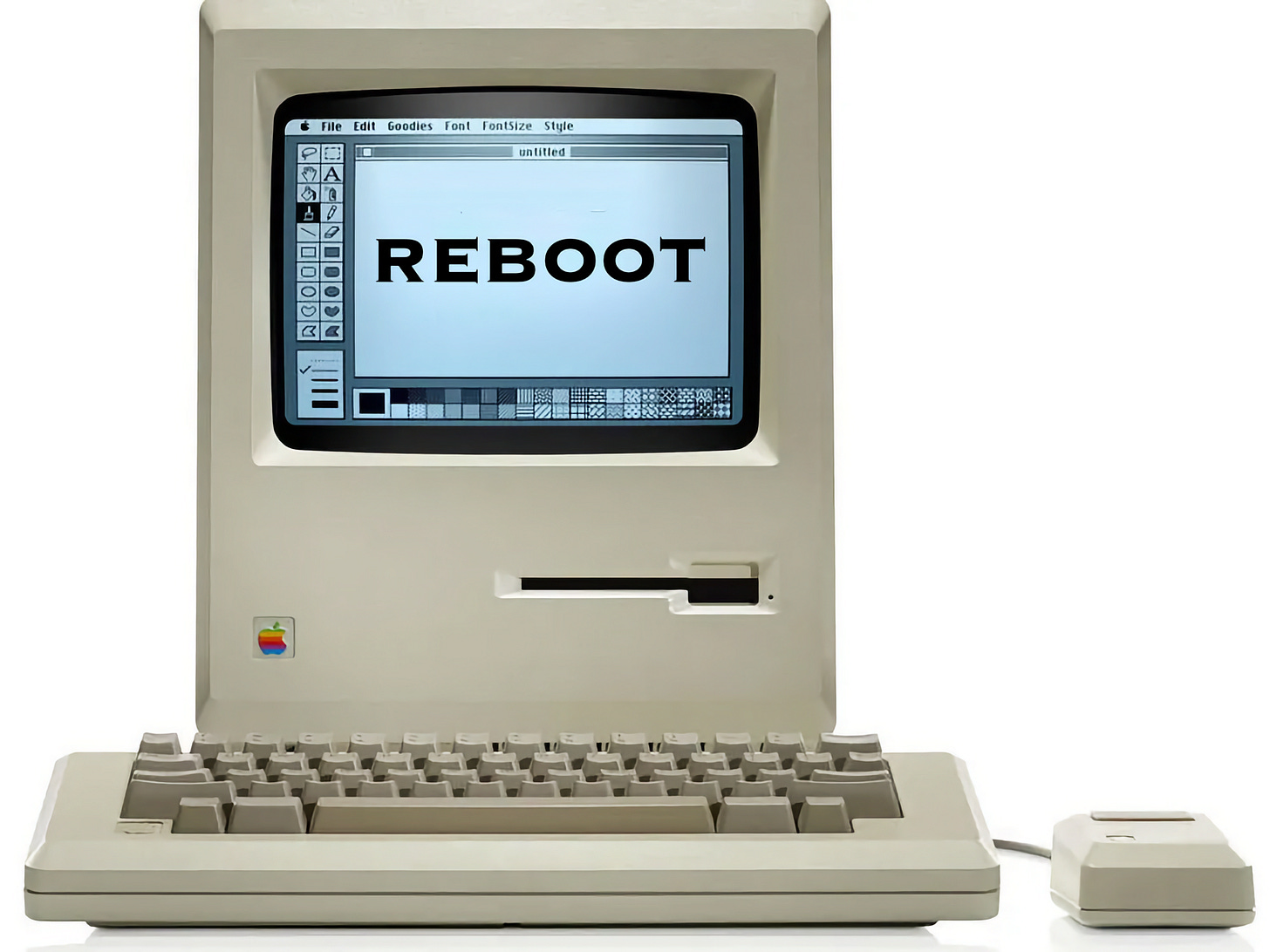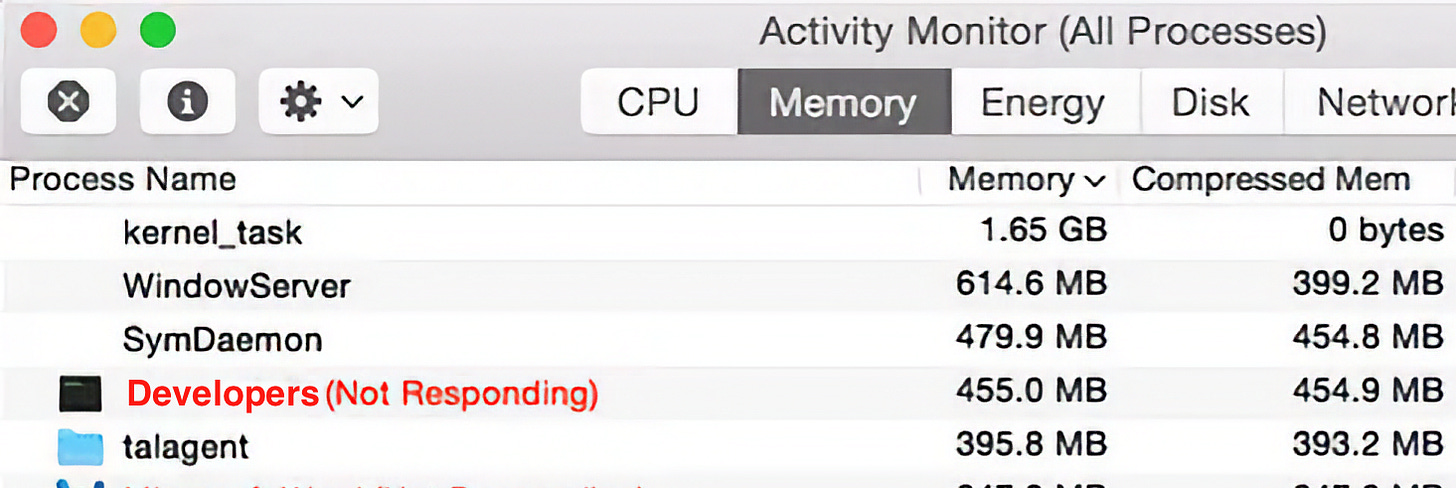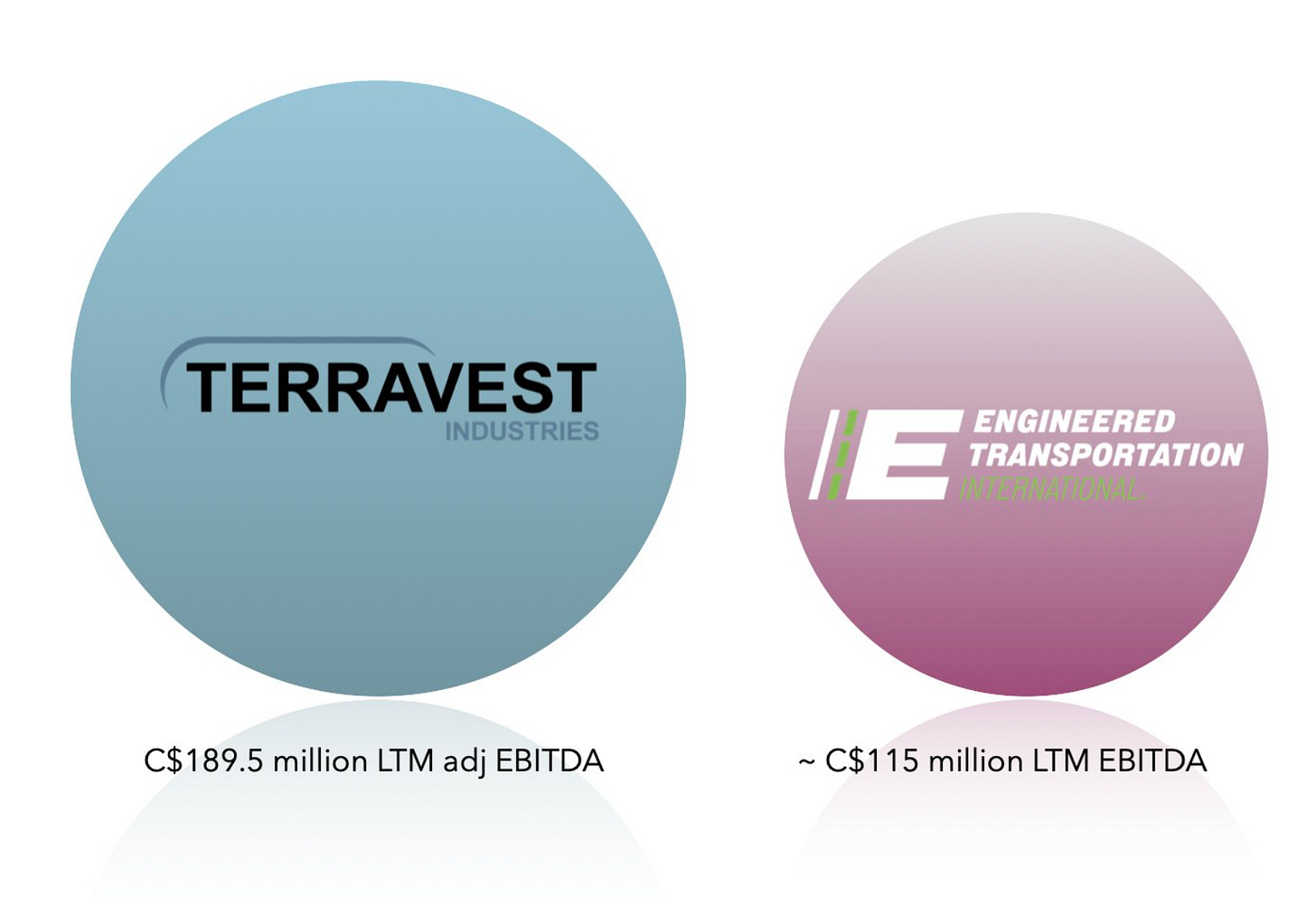555: Apple Needs a Reboot, Terravest Transformational Acquisition, AWS Trainium vs Nvidia, China Locks Down DeepSeek, Google Gemini Deep Research, The Brutalist
"learn to hear our own voice amid the noise"
The mind, like Nature, abhors a vacuum.
—Victor Hugo
🗓️🏆 5️⃣ 5️⃣ 5️⃣ The Triple Five Edition!
I don’t know, it’s just a cool number ¯\_(ツ)_/¯
555! That feels like a lot. How long have I been doing this?!
Unless you’ve been reading since the beginning and have already read everything, I encourage you to check out the archives. You never know, your next favorite thing may be in there.
🗣️👀🔄🧠💭 We build most of our "inner self" around an imagined version of how we think others perceive us, so our sense of identity is largely second-hand.
In other words, the “you” that you privately experience is largely a guess about other people’s guesses about you (because they only know what they can perceive from the outside, they don’t *really* know). This “you” is not some fully autonomous entity.
This mirroring runs so deep that even in total solitude, we’re never strictly “on our own”. There’s always a mental chorus of how we believe the world sees us. As social animals, we’re built/evolved to survive under the gaze of others, because it has always been life or death.
Picture consciousness as a small theater. We play ourselves on stage, but we also experience an audience "out there" (friends, mentors, critics, etc). There's some recursive complexity there because this audience is mostly our imagination's approximation of others' opinions (we don't *really* know them either).
This imagined audience can guide our thoughts just like actual external feedback would. Sometimes, it’s a parent’s voice that we keep hearing replayed over the decades. Other times, it’s an entire group of people, almost like that scene in ‘A Beautiful Mind’.
There’s a tension there: we teach ourselves to think and behave in ways that keep the audience on our side, creating a feedback loop that can be very hard to notice and break, because we feel as though it’s coming from us.
It’s not just us, but it’s not *really* others either, because it’s an imagined version of what they’re like. It’s both. It’s in-between. A blend.
Figuring out who we are beneath these layers of social mirroring is trickier than we might think. Deep introspection can reveal how much of our “private self” is tangled up in these second-hand impressions. Fragmented identity. A patchwork of external views.
To find our authentic selves, we need to step back, and learn to hear our own voice amid the noise.
💚 🥃 🙏☺️ If you’re a free sub, I hope you’ll decide to become a paid supporter in 2025:
🏦 💰 Liberty Capital 💳 💴
🐛🍎→🍏 Apple Needs a Reboot 📱🖥️💻👩💻
Apple is in trouble. Not in immediate danger, but also not going in the right direction on a few big things that will matter to its future.
It needs to pick the right path at this crossroads.
Like all of us, it is a product of its environment and parents. A near-death experience in the late 1990s and Steve Jobs’ DNA have shaped it into something that could navigate choppy waters and become the most successful company in its industry *by far*.
Call it post-traumatic growth 💥📈
In fact, Apple built up so much trust and credibility over the past couple of decades that even close observers took some time to notice that something had gone wrong — like John Gruber, who recently went viral with a piece about Apple’s inability to ship Apple Intelligence features it announced last summer at WWDC and featured prominently in ads.
But this same DNA that saved the company is now causing problems.
Apple’s natural position in the computing industry is as a platform company, a foundation on which an ecosystem of users and developers can operate and build.
But because the Apple of the 1990s became dependent on third-party developers and almost drowned when they threatened to remove support for its then-shrinking platform, the company learned the lesson that they should never again be dependent on popular apps from outsiders.
Since then, they’ve benefited tremendously from the work of devs. But even though the iPhone wouldn’t be nearly as successful without third-party apps, they’ve never fully unleashed that ecosystem.
App Store rules made it impossible for most productivity apps to flourish (no upgrade pricing, no subscription pricing for years, taking a large cut of revenues made many kinds of apps unviable, etc). Apple also never prioritized dev relations and the vibe between the company and devs has soured over time.
I listen to a few podcasts where the hosts are app makers, and they truly feel like Apple doesn’t care much about them.
This didn't matter too much to Apple in the 2010s because the iPhone was growing like crazy and the App Store was in its gold rush period. But now, in the 2020s, smartphones are a pretty mature category (Apple doesn’t even report iPhone unit sales anymore — they’ve pivoted to “service revenue” as their growth engine), and the top apps see very little churn (look at anyone’s phone, and you’ll recognize most of the icons on the home screen).
Enter A.I. 🤖
If Apple fully embraced its nature as a platform, it could ride that new wave. It has all the pieces to be the best place for the new paradigm.
The iOS installed base is such a juicy target, if it was more open to deep integration by third parties, I’m sure that all the top AI companies would compete to offer the very best service — you’d have Google Gemini, OpenAI’s ChatGPT, Anthropic’s Claude, xAI’s Grok, and so on.
It would be a nice jiu-jitsu move against Google, because even if Gemini is deeply integrated into Android, others won’t be because Google will always favor itself. But Apple users could have access to *everything* on an equal footing if the company didn’t try to favor its own inferior AI stuff.
The Switzerland of A.I.🇨🇭
Apple has the best consumer silicon for AI, especially thanks to its integrated RAM architecture which allows the GPU and NPU full access to the pooled memory.
If they opened that fully to developers, all kinds of apps that use a mix of local and cloud AI models could be built and would run better on Apple’s devices than the more heterogenous and lower-performance Android installed-base.
If they loosened their grip on the App Store a bit, there would be more experimentation and new killer apps could be created that just aren’t possible today.
BUT
This isn’t happening.
Apple is struggling to let go of the past — corporate childhood trauma? — and remains a control freak.
They allow others to play, but only in a restricted sandbox, on the side. AI apps and services are useful on the iPhone, but not as much as they could be if they were allowed deeper integration/access. For example, what if you could grant ChatGPT or Claude access to your calendar or email or photos?
There are privacy issues with that, but it’s Apple’s role to create guardrails and then let users decide what they want to do, rather than try to do everything themselves, even things that they are not well suited to do.
There’s a famous Steve Jobs line that goes:
We have to let go of this notion that for Apple to win, Microsoft has to lose.I think the modern version of that is that they have to let go of the notion that for Apple to win, developers can’t win too much, can’t become too important to the platform.
Nobody’s great at everything.
The best organizations accentuate their strengths and leverage other people’s talents to create an unbeatable combination, the best of both worlds.
Apple isn’t doing that right now.
They own the major computing platform of the new century, but by holding on too tight, it risks choking its own crown jewel.
Here’s the Fix for Apple ✅ ✅ ✅ ✅
Prioritize Developers: Make management changes for the App Store and developer relations. Elevate that position in the company, and make it a priority, not an afterthought.
Open iOS/MacOS: Embrace being a platform. Direct the OS software teams to start working on versions of iOS/MacOS that allow deeper integration of third-party services and apps.
Rethink App Store Policies: Make possible as many business models as possible rather than just a few very specific ones.
Commit to AI Neutrality: Explicitly state a commitment to AI neutrality, and that users will have the choice to pick whatever models/services they prefer 🇨🇭
This clarity will create certainty for AI companies to make long-term investments in Apple’s platform without fear that they will be kicked out or restricted in favor of Apple’s own homegrown models.
I don’t know if they can do that without a Nadella-like figure coming in and having a new founding moment for the company’s culture.
“We used to be like this and it worked well for us. But going forward, we are now the most developer-centric platform company for the AI age. We will make beautiful products that are delightful to customers, and we will work hand-in-hand with third-party developers to make these products as useful as they can be! Devs are partners, not suppliers.”
🍁 Terravest Makes Massive Transformational Acquisition 💰
Talk about timing!
On Friday, I wrote about Terravest for the first time, and on Monday they announced what is *by far* the biggest acquisition in their history.
Entrans was acquired for US$546 million at closing, plus contingent earn-out consideration based on the future financial performance of Entrans in the 12-month period following the date of acquisition of up to US$46 million. This represents TerraVest’s largest acquisition to date, with the purchase price representing a multiple of approximately 7.0x to Entrans’ trailing twelve-month EBITDA.
USD $546m + $46m earnout, which converts to about $847m CAD.
For context, TVK's market cap was hovering just around $2bn CAD before the announcement.
“Entrans is a very strategic fit for TerraVest, with the broadest and most reputable product suite in the industry, and a world-class manufacturing footprint. Together with Advance Engineered Products and our existing compressed gas transportation product offering, TerraVest is a market-leader in the North American tank trailer industry.” said Mr. Haw. “This acquisition is transformational for TerraVest providing multiple growth opportunities for the combined company and I am very excited to work with Ryan Rockafellow and the rest of the Entrans management team as they grow the business.” continued Mr. Haw.
EnTrans (aka Engineered Transportation International) is itself an acquisitive company. Back in 2017, the #1 and #2 players in the space — Polar and Heil Trailer — joined forces to form today's EnTrans.
The combination with Terravesk will increase the size of TVK by almost 60%! 🤯
The 7x multiple is higher than what Terravest has paid historically (as Guy Gottfried explained here), and synergies are likely to be lower than with smaller, less well-run mom & pops acquisitions. But there will still likely be some synergies and advantages of scale (ie. better bargaining power when buying from suppliers).
On this, NBF writes:
Firstly, we believe that significant purchasing volume added to TVK's network will grant the pro forma entity greater purchasing power in the procurement of steel, axles, valves and a plethora of other components, with benefits accruing to both Entrans and the base business for relatively quick and easy synergies. In addition, functions that were previously outsourced such as the procurement of propane tanks for fit on bobtails and trailers can be brought in-house with existing TVK capacity. We believe these synergies will be realized almost immediately and increase EBITDA by 10-15%. [...]
In aggregate, we don't expect a well-run business like Entrans will support a four-turn drop to the post-synergy multiple as has been the case for some of TVK's previous acquisitions, but we would assume a 6x post-synergy multiple within 24 months is not unreasonable.On leverage:
The acquisition will be financed using cash on hand (including the May 2024 $96.5 million equity raise) and utilizing the newly amended credit facility, upsized to an $800 million revolving facility and $400 million worth of new term loans. [...]
We estimate that the addition of Entrans will bring TerraVest to a pf ~3.4x Net Debt/EBITDA pre-synergies, or 3.2x post.TVK’s median net-debt-to-EBITDA over the past 10 years has been 3.3x according to Koyfin data, so this isn’t too bad. And because this isn’t a very capital-intensive business, I wouldn’t be surprised to see them delever fairly quickly — though as with any cyclical business, there's some risk if multiple negative factors align at once.
But ultimately, a bet on Terravest is largely a bet on management's capital allocation skills and operational abilities. While this acquisition represents a bigger swing than usual, it's not fundamentally different from what they've been successfully doing for years. Shareholders would have more reason for concern if this was a typically non-acquisitive company suddenly attempting such a large deal without a proven track record of successfully selecting and integrating acquisitions.
Friend-of-the-show C.J. Oppel (💚 🥃) shared this interview with the CEO of EnTrans. While it’s hard to tell from just one podcast, he seems smart and talented, focused on operations and customers.
🤖🏷️ AWS Puts Trainium AI Chips in Bargain Bin 🤔
There are two ways to look at this:
A longtime AWS cloud customer said the company recently pitched them on renting servers powered by the chip, Trainium, that would give them the same computing power as Nvidia’s H100 chips at 25% of the price. (Source)
The first interpretation is to think that this is tough competition for Nvidia and it’s going to either eat market share from them or pressure pricing downward.
The second view is that Nvidia GPUs are so sticky and attractive to users that Amazon has to heavily discount their own chips to get anyone to bite. If there was a lot of demand for Trainium, they probably wouldn’t have to discount them by 75%.
It’s worth noting that they’re comparing to the H100 Hopper chip while the H200 is more appropriate, Nvidia is ramping up production of Blackwell and unveiling the next generation (Rubin) this week.
Another critical consideration: comparing price-per-unit-of-compute may seem like an apple-to-apple comparison, but things are more complex than that. If the software stack isn’t as mature and is harder to code for, productivity per dollar could be lower even at a matched level of raw compute.
Can Amazon keep up with Nvidia’s velocity? Trainium’s price advantage over H100 may not last very long as new Nvidia chips with better performance/$ come out, and Nvidia optimizes its software stack to wring out more performance out of existing chips. How fast will Trainium’s software stack be optimized going forward is an open question.
🧪🔬 Liberty Labs 🧬 🔭
⛓️🇨🇳🤖⛓️ China Locks Down DeepSeek: Staff Passports Confiscated, etc 😬
When DeepSeek’s R1 busted on the scene and dominated news cycles for a week, I wrote about how there was some danger of getting on the Chinese authorities’ radar.
Here’s what I wrote in Edition #546:
🤖👀🇨🇳 Will Success Make DeepSeek Worse?
There’s an argument to be made that what made DeepSeek so successful was that they were under the radar doing their own thing.
This success has put them very much on the radar. Now, the eye of Sauron is on them. 👁️
Will interference by the Chinese government (even if well-intentioned from their POV) cause them to lose what made them so effective and special?
I could imagine all kinds of political requests from up high for them to “help support the national interest and strengthen China’s AI industry by doing XYZ” causing them to lose focus, become more bureaucratic, more careful, and slower.
Maybe the CCP will ask them to use Huawei chips instead of Nvidia. Maybe they’ll ask for more censorship of the model. Maybe political appointees will now sit on board meetings and review every plan and management decision. Maybe they’ll be showered with subsidies and resources — which seems great at first — but it could dilute their high-performance team through rapid expansion and make them revert to the mean, so to speak.
Maybe Liang Wenfeng will step on some toes and become the next Jack Ma 🤔
¯\_(ツ)_/¯
It looks like this may have begun.
In recent weeks, company executives have forbidden some of DeepSeek’s employees involved in the research and development of artificial intelligence models from traveling abroad freely [...]
To enforce the travel restrictions, DeepSeek and its hedge fund parent High-Flyer Capital Management asked some staff to hand in their passports [...]
In China, authorities typically restrict overseas travel by government officials or state-owned company executives, whether they are Communist Party members or not. But in recent years, such restrictions have expanded to public sector workers such as school teachers and rank-and-file employees at state-owned companies.
The CEO has started to fall down the political gravity well:
Since January, DeepSeek CEO Liang Wenfeng has been invited to two gatherings attended by China’s leaders—one with President Xi Jinping and the other with his second-in-command Premier Li Qiang. Usually only the heads of the biggest companies in China are included in meetings with top leaders.
Even investors are being redirected to government officials:
In recent weeks, some investors who wanted to make investment pitches to DeepSeek were instructed by the company that they first need to reach out to the general office of Zhejiang Province’s Communist Party committee and register their investment inquiries with officials there
And employees may be restricted from making career changes:
some headhunters in China who approached DeepSeek employees with potential job offers say they have received phone calls from Zhejiang government officials, asking them not to poach talent from DeepSeek
We’ll see if all this (and potentially more that we don’t know about, or that is yet to come) will gum up the works and make DeepSeek’s velocity drop.
📑🔍 Google Updates its Gemini ‘Deep Research’ Tool with Latest Reasoning Model 🕵
Today, we're upgrading Deep Research with Gemini 2.0 Flash Thinking Experimental. This enhances Gemini's capabilities across all research stages — from planning and searching to reasoning, analyzing and reporting — creating higher-quality, multi-page reports that are more detailed and insightful. Gemini now shows its thoughts while it browses the web, giving you a real-time look into how it’s going about solving your research task. By pairing Deep Research with this new model, we expect the quality of reports to keep getting even better.
I’ve tried it a few times, but so far my impression is mixed.
It wrote a pretty good report and found a lot of sources, but some of the info was wrong — not hallucinated, the model just got confused by two entities having similar names.
I’ll keep playing with it to get a better sense of whether this was a fluke or it’s a common problem.
🎨 🎭 Liberty Studio 👩🎨 🎥
🏗️🏥 Thoughts on ‘The Brutalist’ (2024) 🎞️🤔💭
📣 SPOILER HORN 🚨
📣 SPOILER HORN 🚨
📣 SPOILER HORN 🚨
📣 SPOILER HORN 🚨
I finally had a chance to see this epic.
Unfortunately, I couldn’t see it on the big screen. It’s just too hard to find 4 hours to go to the theater these days. But I regret that. It’s a truly cinematic film, and seeing it the way it was intended probably adds a lot to the experience.
I can’t believe they shot this on around $10m. It’s an incredible achievement and makes a lot of $200m film look even worse by comparison.
It’s a reminder that taste matters more than raw dollars. 👨🎨
Part of the look of the film comes from the fact that they shot it in VistaVision, which is a clever way to get more out of the regular 35mm film stock:
The film was shot almost entirely in VistaVision, a widescreen format that runs 35mm film horizontally through the camera to create eight perforation film frames, twice the size and resolution of standard four perforation 35mm. The film was then released in theaters with 70mm film prints. This is the first American film in 61 years to be entirely shot in the format, the last being My Six Loves (1963). Director Brady Corbet explained: "It just seemed like the best way to access that period (1950s) was to shoot on something that was engineered in that same decade." Star Wars: Episode IV - A New Hope (1977) reintroduced VistaVision to create high resolution plates for visual effect shots.It’s kind of in-between IMAX and regular 35mm and has its own vibe.
One of the most beautiful sequences was the quarry:
The marble sequence was shot in the same quarry where Michelangelo carved The Pietà - a statue of Mary cradling the body of Jesus Christ after his crucifixion at Mount Golgotha.Overall, I liked the film, but not all of it worked for me. But I deeply respect the big swing, and films don’t have to be perfect to be worth watching.
The first half — the optimistic chapter — was the strongest. It’s almost hard to find fault with it, an epic in the style of old Copolla. It transported me back to a different era.
The performances and the physical production were the highlights to me. Brody and Pierce deserve the accolades.
The second half is a bit more scattered and disjointed, with more hanging threads and open loops. It has high peaks, but some valleys too.
With the ending, I see what they were going for, and on paper it’s a great. It didn’t quite work for me on screen, though.
The tonal shift, the video stuff, etc. It looked too cheap and didn’t fit. I understand that they wanted the 1950s look for the 1950s and the 1980s look for the 1980s, as I said, it’s a great idea on paper, but it took me out of it and seemed tiny compared to the grandeur of the search party going around the brutalist structure in the dark with dramatic music.
That’s too bad, because the reveal about Dachau and Buchenwald is powerful and changes the context of what came before and forces you to see these characters in a different light.
All in all, I’m glad I saw it, and I hope more directors get to make original epics like this. We need the palate cleanser after the Marvel era.









Very nice riff on self-awareness. Writing lately on the scientific nature of information it occurs to me that your commentary will be just as valid replacing a human audience with the universe. The observation problem is that we can only know about the universe by interpreting the energy we receive from it and creating our own model of what it is.
Scientists build sandcastles in their mind and then seek confirmation from the universe. The hardest, but necessary thing, is to step out of your model and imagine an audience that is seeking to criticize every bit of your performance. The universe itself is very good at that if you were willing to listen to it.
Agree re the first half of the Brutalist being the best. The whole library sequence is 🤌🤌🤌🤌